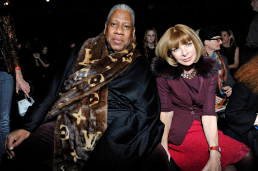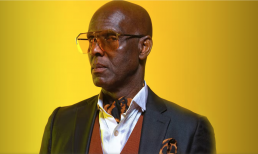Marketing Lessons From The Fashion Industry
Marketing Lessons From The Fashion Industry
To me, the greatest marketers are fashion icons. And by fashion icons I don’t mean supermodels or the best dressed celebrities. I mean the ordinary individuals who put in captivating work that suddenly makes them seem extraordinary. Some of my top fashion icons are André Leon Talley, former editor-at-large of Vogue magazine; Dapper Dan, the underground creative genius that bootlegged luxury fashion to pimps and gangstas; Diana Vreeland, who worked as a columnist and editor of Harper’s Bazaar and later served as the editor-in-chief of Vogue magazine, and finally Anna Wintour, the private and mysterious British Journalist who has served as editor-in-Chief of Vogue since 1988, and Global Chief Content Officer for Condé Nast since 2020.
I study the work and follow the moves of these four individuals because I believe their subject matter knowledge is endless, obsessive passion is contagious, thinking is insanely divergent, product appreciation is deep, and the rebellious attitude to getting their work done is alluring to me. These five variables are the essential ingredients that are consistent across each individual’s profile, and I believe makes them extra-ordinary. Fashion or not, they are extremely savvy marketers of concepts and products who I believe can sell anything as long as they are interested in it or care about it enough. It’s like what Jay-Z said in ‘Dirt Off Your Shoulder’ – “I’m the realest that run it, I just happen to rap”.
So, these are incredible humans, but why are they great marketers? First factor we will explore is Vanity. As you know, the fashion world has been criticised for being unreal and vain. People in the industry supposedly act as if fashion is the true religion (pun intended), and nothing else exists – and I wonder why that is so wrong. If you don’t believe so much in the work that you do, how do you expect to make someone else believe in it? If Steve Jobs did not have a blinding belief in interface and experience design, would he have been able to convince others to become advocates enough to make Apple attain the status of the world’s most valuable company? I think not.
Anna Wintour is considered the most powerful woman in the global fashion industry, and I’m not even sure she’s ever sewed a stitch of fabric. Fashion designers treat her like the Queen of England and consumers are constantly trying to demystify her. But what makes Anna so powerful, is not only the mystery that lurks behind her dark shades and wicked bobs, it is that she captains Condé Nast – the ultimate lifestyle brand conglomerate, and a melting pot of vanity – which is a guaranteed marketing machine that sells out anything and anyone.
Next factor to look at will be Personality. Everyone that was or is a leading voice in the fashion industry, is an absolute original. From physical appearances to personal idiosyncrasies, the four aforementioned people are very authentic and unapologetic about how they carry themselves and how they are perceived. This comes across authentically in their personal branding which makes them absolute magnets to their various tribes. It makes connecting with their audiences easier, and it makes persuasion and conversion easier. While reading Dapper Dan’s memoir aptly titled ‘Made in Harlem’ – I noted an interesting story he told about touring Africa and ending up in Senegal, where the bulk of his money was spent buying beautiful fabrics which tailors made into nice suits for him. This almost got him stranded in Africa by the way. Dap likes to look fly, and one thing that is consistent about him and all the other fashion icons I follow, is the compulsive need to cultivate and appreciate style.
Another important factor is Showmanship. If you skim through fashion history; study roll-out plans, exhibitions, and sustaining conversations to drive sales and talkability, you’d note that fashion is highly histrionic. Fashion designers and some fashion editors are the greatest showmen. They know how to put on a show or magazine that makes everyone stop, point and talk. To me, Diana Vreeland still remains the only fashion editor who understood the charm of the human pose, the soul of an outfit, the personality of a typeface, and the architecture of a brilliant layout. She was the master of detail and exaggeration – and she embodied these two elements completely. Checkout her documentary ‘Diana Vreeland: The Eye Has to Travel’ whenever you can.
The final factor that makes fashion icons marketing geniuses is Sustenance. They understand the art of sustaining conversations long after exhibitions are over. The phrase ‘paint a picture with words’ was probably originally used to describe André Leon Talley. His deep love for style, taste and character, merged with his vast knowledge of the fashion industry helped him connect with fashion designers on a purely artistic level. This enabled him to tell the stories of their personality and collections long after the last model had left the runway.
Your Subconscious Is The Ultimate ‘Artificial Intelligence’
Your Subconscious Is The Ultimate ‘Artificial Intelligence’
I’ve been thinking a lot about Artificial Intelligence, not about its potentials like all the articles are writing about, but about how it works, how information is gathered to synthesise intelligence, and produce smart behaviours. I’m struck by how this mechanism is modeled after how the human brain works. Since the field of AI was founded in 1956, time and money have been spent on commissioning humans – either through direct and indirect payment – to interact with AI and train it for the greater good. How does this work?
To explain how AI works from a layman’s point of view, imagine everyone in the world had chips. These chips are unique to each person. Now someone who wants to make the biggest chip in the world, then says for this chip to be truly majestic and valid, everyone has to contribute one of their unique chips to this big chip. Let’s replace chips with intelligence, and replace AI with ‘the biggest chip in the world’. If everyone in the world contributed a smidgen of their intelligence to this AI, imagine how smart the artificial consciousness is, and will continue to be.
A lot of funding, data and man hours has gone into the field of Artificial Intelligence. Scientists have devised very interesting ways to teach AI about the technical ways of our world – some ethical, some not. But we can all agree that the use cases of the results of AI will be endless, and will benefit humans greatly. Now imagine the gigantic data sets that the AI has had to process, from texts, to images and then sounds, of various humans representing different cultures across the planet, and you can already tell that because the AI is a representation of pieces of all of us, it is going to be one efficient mf.
But then, AI has its limitations; if you interact with any of those AI powered chat apps like Replika, one thing that will immediately stand out to you is that the ‘AI’ you are chatting with does not understand nuance and sarcasm. Those are two very technical emotional functions that only humans can pick up on, and not even every human understands the full range of sarcasm and nuance. Depending on whether the words you use are positive or negative, Siri can tell if you are being rude or funny – what Siri cannot do is pick up emotions from your tone. Again, this is a function still exclusive to humans.
Now imagine how incredible you think Artificial Intelligence is, and yet still does not come close to how efficient and sophisticated the human brain is. Our brains are designed to be a gigantic sponge of all the dimensions of experience – visual, sound, touch, taste and smell. Depending on what you allow yourself to experience and assimilate, you could be the baddest mf on the planet. The movie ‘Gattaca’ illustrates perfectly the mysterious depth of the human brain, that even after a person had been deemed ‘less than’ based on physiological and mental capabilities, there are forces like drive, motivation, intuition, and soul, that cannot be measured and replicated artificially because it is too subjective to the individual.
There’s also the misconception of what intelligence truly means. What comes to mind when you think of artificial intelligence? Do you view ‘intelligence’ as being ‘book smart’, or do you use the military/espionage meaning which basically means ‘to have information’? In the context of this article, and as it relates to AI, the word ‘intelligence’ refers to having enough information to make a decision or carry out a task. Ultimately, there are different kinds of intelligence – strippers have a form of intelligence and so do the fire-eaters. Intelligence presents in different forms and is tied to several human functions such as memory, motor responses, sensation, and perception etc.
In a society where the measure of your intelligence quotient (IQ) determines where you can work and what you are capable of, it is important to emphasise that the range of human abilities are endless, and the ways in which these abilities can be built up and expressed are also endless. There are no set ways for doing anything. There’s no blueprint for anything – you are your own bundle of intelligence, so do it your way. I promise you, that person you think knows everything probably does not have the essential information needed to make it work. So tap into your own unique network of intelligence and tap into your greatness. Gather your own intelligence and do it your way.
I’m a huge fan of mafia movies, and one of the most profound statements that can close this article perfectly is a line delivered by Sam “Ace” Rothstein in the movie ‘Casino’. He said to one of his floor workers; “There are three ways of doing things around here, the right way, the wrong way, and the way I do it”.
Nostalgia Is One Hell Of A Drug
Nostalgia Is One Hell Of A Drug
Cambridge English Dictionary defines nostalgia as “a feeling of pleasure and sometimes slight sadness at the same time as you think about things that happened in the past”. I define nostalgia as a sensation or perception as it relates to culturally shared moments across age groups, ethnicities, race, profession and academic school of thought. Nostalgia as an element of social consciousness, is polarizing by nature. This means that two cultural groups will not remember the same event the same way, either one group has positive emotions, and the other group has negative emotions, or both groups hold varying degrees of positive and negative emotions.
Kareem “Biggs” Burke, an esteemed pop-culture philosopher once said “sometimes I miss the vibe, but then I remember the disrespect”, I hope I quoted that correctly. What this statement literally does is to further illustrate the polarizing nature of nostalgia even within the group or the individual. Think about it, have you ever reminisced about an old horror movie that you saw as a kid with your family, and in the same breath remembered the crippling fear you felt when the night came and the lights went out? Or a uni lover who did you dirty but in spite of that holds a warm place in your heart even though you still get PTSD from the heartbreak? – why would an experience that ended badly, continue to feel so good?
Well, we have our brains to thank for that. By design, the brain functions to elevate parts of the memory which are pleasurable, and represses the parts which are unpleasant. It is a complicated process of human evolution that has served the human race from time. Does this mean that our brain is broken? No, all it does is what it has been designed to do – plug, play, optimize. Part of optimization is memory decay, our conscious and subconscious memories are filed away in the unconscious – this is the deepest and darkest parts of our minds. Memories that get filed away in the unconscious cannot be actively recalled no matter how hard you try, what helps are retrieval cues, or in more extreme cases, hypnosis.
Retrieval cues are basically elements in the environment that triggers recall. Retrieval cues can be present in the external environment, such as sound, smell, touch, taste, and sights. Retrieval cues can also be internal to the person retrieving the memory, such as physical states or feelings. Retrieval cues are why Usher has a hit song titled “You Remind Me” – retrieval cues are why a familiar perfume scent can either make you smile ear to ear, or tear up a little in memory of the one that got away. Retrieval cues are so powerful, and it is why the design universe has informally decided to adopt certain colors as symbolic representation of actions. The red light means stop and so does your delete button, even if you’ve not read the words on the button, you automatically recognise what it could 90% mean.
Retrieval cues are all around us, it’s in the music we listen to, the movies we watch, the billboards we see, the magazines we read, the market we patronize, the documentaries we learn from, the digital ads that bombard us, and the people we are drawn to interact with. These different social elements tap into a moment in the time of our lives that will form the relatability needed to buy into their agenda. Advertisers, movie/music directors, interaction designers, salesmen, PR consultants, image architects etc, are intentionally or unintentionally adept at using retrieval cues to sell a story through visuals and words, that will trigger the action needed to make a sale or change perception for good.
Polarizing in nature as it is, the powerful allure of nostalgia has clearly proven to be leaning favorably towards pleasant memories. For communicators, this means that in developing strategies, tactics, and eventual comms tool kits, it is important that you stay within cultural familiarity – do your research into the words, images, and storylines that helps your audience form stronger cultural associations with your products. For designers, who I refer to as the magicians who speak the language of the unconscious memory, the task is to use shapes, colors, layouts and typefaces as visual collaterals that introduces the brand personality and strengthens its positioning as a trusted friend and cultural ally.
As internet penetration spreads across the planet, more people are adopting the use of smart mobile phones, and the world continues in its move into digital-first platforms of interactions. This means that there will be an influx of culturally diverse pockets of people, and there’s a need for robust integrated communication strategies that incorporates and projects an authentic cultural salad bowl that not only taps into the culture, but represents moments in the culture. In designing products for finance, entertainment, health, wellbeing and sports, ask yourself – beyond the technicalities and business strategies, what’s the one thing the user will remember about my product? How do I immortalise the concept?
Why You Should Care About The Fashion Industry
Why You Should Care About The Fashion Industry
Do you ever wonder why people love to hate the fashion industry? I mean I love it, but I cannot speak for the rest of you. What I love about fashion is not even the industry, and as much as I’d like, it is not the style, beauty and glamour. What truly draws my attention to the fashion industry is the image it contributes to, the characterization of the personality at a time in history (in the case of fast fashion), or of all time (in the case of more classic apparels).
People talk a lot about the zeitgeist – which is basically the defining spirit or mood of a particular period of history as shown by the ideas and beliefs of the time. I believe fashion is the zeitgeist, fashion is the mood, and fashion is the emotion. Fashion is one of the most underrated elements of a social structure. People assume because it is just clothes and accessories, then it must be vain – whereas fashion is the backbone of a lot of ‘serious’ societal institutions.
Think of uniformed workers – policemen, pilots, doctors, nurses, soldiers, traffic wardens. When we look at them, we automatically perceive them as figures of authority, in a way, their image alters our behaviour, simply because of the symbolism the clothing represents. Take the same people out of the uniform and they become just any regular Joe. The different uniforms have different styles and a certain kind of beauty attached to their structure, color theme and texture. But ultimately, it is the image that the uniform evokes, that is more powerful.
Fashion is beyond the runway. Let me explain what that means. If you google the word ‘Fashion’ right now, there are two definitions you will find, the first is; Fashion – ‘a popular or the latest style of clothing, hair, decoration, or behaviour’, the second is; Fashion – ‘a manner of doing something’. In this article, I’m exploring what the second means in the context of identity, personality, style, perception, communication and culture.
Simply put, if society was broken down like the anatomy of a human, fashion will be the blood. The first time I understood the depth and reach of the fashion ecosystem – I was hanging out with my Landlord in Opebi, Lagos on a Sunday evening. He paints interesting works of art and has some degrees in Art History. He explained how fashion is literally the material element in the definition of culture (for context, culture is defined as the material and immaterial elements of any society). Think of any time in history, what do you remember it by? – the clothes, the make-up, the accessories, the styles, basically.
We criticise Nollywood and Hollywood for this constantly – “Oh this movie is set in the 70s? Why is her makeup that way? That was not the shoes of the 70s”. We determine time in history by the things we place the least emphasis on; cloth structure, shoes, bags, pieces of jewelry, makeup, slang, wig type, even scents.
At this point, if you’ve seen ‘Devil Wears Prada’ – you’d remember the scene where Meryl Streep schooled Anne Hathaway about how her dismissive opinions about fashion was totally unwarranted, because the scrumpy sweater Anne had on, was determined through the ‘frivolous’ activities that she thought were inconsequential.
Fashion is the most authentic expression of self, expression is art, art is history, and history determines the perception of a society. Fashion has certainly been my backbone. It reminds me of who exactly I think I am when my insecurities are doing a madness. It has also been a long journey to figuring out what my style is, because I have found out that not everything I admire will look good on my body structure.
Everyone that wants to be successful in life needs to go through the process of figuring out what their style is. It sounds so banal and unnecessary but trust me, dedicating the time to understand what works for you and makes you feel like your ideal self will totally change your life. You will feel more confident and certain. Study the feel of the types of textiles that make you feel at home, e.g. as much as I like jeans, it does not work for me at all, I have discovered that I feel more at home in soft and free textiles, makes me feel loved and appreciated.
Study colors, study prints, study cloth structures, study cuts – download Pinterest, feed the algorithm, and it will help you. You will know what you like, don’t shrink yourself to fit in, do mood boards of your unique selections, and invest some money into bringing them to life. No matter how imperfect or insecure you feel, this exercise will make you whole – you will feel worthy, worthy of opportunities, worthy of trying out, worthy by being enough, worthy by feeling enough, worth that can only be gotten from physically wearing clothes.
About Blitzscaling And Maslow's Hierarchy Of Needs
About Blitzscaling And Maslow’s Hierarchy Of Needs
One of the simple joys of life for me is being able to draw intellectual parallels between concepts that on the surface seem quite distant, but on closer inspection are actually very similar. The study and understanding of Psychology empowers me to do this and now you get to read about all my crazy ramblings. My hope is that someone somewhere finds meaning in these things and is able to find a way to apply the insight.
The first time I read about Blitzscaling, I was a young and broke communications associate who had no weekend plans and needed something, anything, to keep myself company till I was back again in the office for the new week. I’d borrowed a 2016 Harvard Business Review magazine from the office library with the intent to return it, but I never did – sorry HR.
Anyway, I found a very interesting interview between Reid Hoffman who is a Silicon Valley OG and Tim Sullivan, former editorial director of Harvard Business Review Press. So I’m reading this interview about scaling really fast, Reid is explaining the essence of Blitzscaling, which is basically agility with calculated risks, and it made so much sense to me that I started drawing parallels from the conversation to the structure of a motivational theory called Maslow’s Hierarchy of Needs.
Simply put, Blitzscaling is the idea that to grow really big and very quickly, an organization needs to take inventory of the impact of its brand and unique offerings, and use that in-depth understanding to go big on investing in elements that elevates its bottom line which is ultimately – world domination. There’s essentially no rule book for Blitzscaling, it’s a combination of street smarts and business management. To determine what Blitzscaling has to do with Maslow’s Hierarchy of Needs, we need to understand what the latter actually is.
Maslow’s Hierarchy of Needs is a motivational theory of Psychology that structures human needs into five hierarchical steps. They range from more concrete needs such as food and security to abstract concepts such as love & belonging, esteem and self-actualization needs. Maslow believed that human motivation moves from the bottom of the pyramid to the top – you only stop to consider higher needs in the hierarchy when you feel you have sufficiently satisfied the previous need. It makes sense, right? How do you brainstorm on an empty stomach? No one thinks about taking over the world while they are being attacked – or do they?
Since the dawn of time, through movies, music and books, we have heard stories about humans who have done incredible things in the face of hunger and or risk of personal danger. Think of iconic athletes like Jordan and Kobe (RIP) who will play through severe bodily injuries and still dominate. Think of soldiers who have had to remain brave and stay motivated to fight against enemies despite the possibility of death. Think of people who came from extreme hardship and poverty, who went on to become very successful members of society. In hacking productivity, I believe managing a concept as volatile as motivation, has to be more nuanced and contextual – especially as it relates to the very complex nature of human behavior.
Peers may have criticized Maslow’s theory for not having external validation beyond the wealthy population he chose to base his studies on – but I will give him due respect for categorizing the human needs and putting them in a hierarchy. What does Blitzscaling have to do with Maslow’s Hierarchy of Needs? It’s simple really – if you flip the pyramid on its head, this will put self-actualization and esteem as primary needs, and everything else which is love and belonging, safety, and physiological needs become secondary.
When you fuse the premise of Blitzscaling and a flipped Maslow Hierarchy of Needs, what you have is the ultimate cocktail of staggering success if applied with discipline and tact. Recall the scene in The Godfather II when Michael Corleone visited Havana in Cuba while seeking to expand his empire out there with the help of Miami mobster Hyman Roth, who did dealings with President Fulgencio Batista. At the time, Batista’s regime was under attack by guerillas of Fidel Castro, Michael was worried about how this would affect business, and he asked Roth if the guerillas were being paid to fight, Hyman responded that they were not and Michael was convinced that this meant they would win.
In my opinion, the concept of Blitzscaling is very much ‘do or die’, you either win big or you lose big. A person who grew up with nothing, or who is fighting to save their dreams, or whose need for greatness is bigger than their need to just exist, has nothing to lose if they try, but has everything to lose if they do not try. This person does not fear hunger, danger, and is also not worried about losing friends or family. This person has a high locus of control, and also has incredible tunnel vision about the parts of their lives that needs to be amplified for success to be achieved. It may take time, but this person usually wins big in the end.
Human Beings Are Products Too
Human Beings Are Products Too
Product design and management are similar in concept and use cases in the areas of developmental and clinical psychology. A basic definition will be that developmental psychology finetunes the experience of a product/human, while clinical psychology uses that experience to meet user needs. In the case of a product, the users are external, but in the case of the human, the user(s) can both be external and internal, mostly internal.
Coincidentally, the one thing both the product cycle and human cycle have in common is the need to achieve. No matter how banal and extraordinary, not achieving will make a product/human defective and useless – and therein lies the problem.
For every human being on earth, the singular most important thing is the need to achieve. Achievement is relative; it could mean anything from getting through your workout to getting a promotion at work. However, I think we’ve attached too much power to the word ‘achievement’ that it has now taken nuance away from the basic meaning of the word, which is to simply get things done on time and with a little discipline.
50 Cent was the first to put this in perspective for me in his book ‘Hustle Harder, Hustle Smarter’ – in highlighting the timeline of his wins from a kid selling drugs in South Jamaica, Queens, to a TV mogul, he mentioned that at every point in his life, everything that he had wanted, no matter how reckless or unnecessary it seemed, had prepared and motivated him to get to the next level of his life.
But this is not an article about the greatness of 50 Cent, because as much as I am fascinated by the concept of greatness and its associated elements like discipline, style and oddity, I am probably more interested in the not so great people who have more authentic things to tell me about the average human nature. However, it was important to reference his much-documented life to explain my premise for this article because you can always go back to trace the dots.
This is also not an article about technology; it’s an article about human design and management. If we ignore the technicalities of the technological or psychological approaches for a minute, we can see that there are three major phases of human development that impacts achievement; Design, Product-Market Fit, and Ultimate Success. Using Erik Erikson’s stages of psychosocial development, I will attempt to break this down.
The Design phase covers infancy, early childhood, middle childhood and ends at adolescence (0 – 21 years). If you actually reflect on this period as far back as you can remember, and try to be objective about what worked and what didn’t, what hurt and what didn’t, what you liked and what you didn’t, personality types you vibed with and those you didn’t – you will unlock the answers to how you were designed and what you are either capable of and not capable of. Just like a product, the design phase holds all the clues to how you were built and what you were built for.
The Product-Market Fit phase covers early adulthood (21 – 39 years), a period that we all know is filled with great turmoil and dilemma. We struggle to fit in with friends, industries, workplaces or geographical locations. In a bid to understand themselves better, a lot of people seek out therapy during this period, and what a trained therapist will first establish is all the unique elements of your design phase that will help you navigate people, places and situations better. In my case, I could do that by myself because I understand how to use Psychology, and I am also extremely strong-willed and brutally honest with myself. I would not advise that you do this on your own because not only do you not possess the structured knowledge that will help you navigate this process, it is also a long and very painful process that requires discipline and accountability. Only a trained professional can help you get through this, but when you get through and become incredibly self-aware, you will become unstoppable, or as Nassim Taleb calls it, Antifragile.
The Ultimate Success phase covers middle adulthood and old age (40 – 65 years and older). This is a period where a lot of people commercialize and become successful. Success, in this case, is very subjective, in fact, the great philosopher, Damon Dash, posits that success is a feeling, not an actual accomplishment. What this means is that whether you are a C-Suite living in a penthouse apartment or you are a Professor, living in a modest home in the countryside, what really matters is how you feel about all that you’ve done and/or acquired when you are alone with your thoughts. This is why it is important to get the product-market fit phase right, because what you will eventually call success or accomplishments may really just be someone else’s design script.
How Social Media Is Impacting The Future Of Cultural Taste
How Social Media Is Impacting The Future Of Cultural Taste
I have always been fascinated with the internet and its components. My first interaction with the interface was back in 2005 when Yahoo! Messenger was all the rage. My mother could not afford a family computer at the time so I’d always beg her for N100 ($1 – adjusted for inflation), to buy about 1 hour of computer time at the neighborhood cyber-cafe. The 1 hour usually sped by because I’d just surf and surf, brimming with excitement as I stared at the screen wide-eyed. For me, the internet was not just a tool of communication, it was a medium of socialization.
Since MySpace made history as the first internet company to hit 1 million active users, social media has been a concept and a product that has been loved and hated with the same intensity. Often by opposing demographics but never by opposing psychographics. The reason for demographic disparities is rooted in developmental differences, however, psychographic factors ensure that everyone has a place on social media. Everyone is welcome. That’s why group chats and Twitter factions exist, and it’s why Facebook favors organic group page engagements over business page announcements.
I know the various tech companies have caught major flak for social engineering platform dependence and people’s attention. However, it is important to highlight some of the good social media has done and will continue to do, especially acting as the melting pot for national and subcultures across the world to synthesize informal language, fashion and style, design and aesthetics.
The nature of social media is to promote exhibition, either for your thoughts or for your appearance, and the reward for exhibition is validation and replication. One person’s opinions turn to the belief of another person across the world, usually beyond propaganda, but focused around self-awareness, personal space and self-esteem. The personal style of a London babe is replicated experimentally by another babe in Lagos, Nigeria. When she is complimented by everyone for her unique sense of style, it reinforces her decision, and completes the process of behavioural change.
The amalgamation of cultural elements across the world is evident in the emergence of the positively rebellious nature of the Generation Z. They are not bound by the developmental parameters of the older generations simply because the process of social learning, which is a key learning principle in the development of conscious beings, is not limited to their immediate environmental mores and norms.
They can choose their tribe and instinctively absorb the different parts of diverse cultures that appeal to them; music, fashion, social beliefs, and well being are being subconsciously re-engineered for good. Ultimately, the coming generations can perceive adaptive sensations beyond the parameters of their physical environment – it now literally takes a global village to raise a child.
With the emergence of mainstream immersive technological products and platforms such as AI, VR and the Metaverse into the mainstream market place, the simulation of social interactions across cultures will become more real time and synthesized. I wonder what this eventual global cultural personality will mean for marketers, product and brand managers, PR and digital marketing people as regards segmentation and targeting. One thing is clear though, the internet has established itself as one of the forces of societal socialization
Why Thinking Outside The Box Is NOT What You Think It Is
Why Thinking Outside The Box Is NOT What You Think It Is
I remember sitting in my first brainstorming session as a Communications Intern 8 years ago, when the account handler encouraged us to think outside the box and present a big idea to communicate the client’s business objectives. Like Professor X, I went deep into my mental faculties, I thought long and hard, I read Comms case studies, I thought some more, and came up with nothing. It really baffled me, how did I come up with nothing? Does this mean I’m dumb?
I have since developed as a Senior Consultant in my current profession and I have been part of several brainstorming sessions. I have also worked with some of the biggest brands in Nigeria and delivered several high level campaigns. The singular summation of my experience in delivering campaign strategies has been this – the most obvious solutions are the ones hardest to come by because of the self-imposed cultural constraints we work within.
‘Thinking outside the box’ what does that even mean? What is the box? How do you think outside of it? Simply put, the ‘box’ is the subculture we exist in as individuals in the society, and thinking outside of it means intentionally experiencing other subcultures that helps us see our challenges from a different perspective and help us get it. For the layman, subcultures are anything with a process or unique way of doing things – could mean industries, religion, professions, ethnic groups, social class, schools, fashion houses, animal groups, or even mechanical things like cars, blenders, hair dryers and so on. It’s basically anything that has an influence on our perspective.
The most important thing to understand about this statement of innovation heuristic is that ‘thinking outside the box’ is not really so much about your intelligent quotient (IQ), but your emotional quotient (EQ). ‘Thinking outside the box’ is also not about how much time you dedicate to thinking about it. Think about the statement ‘outside the box’ as a Venn diagram – your solution lies at the center of your experiences, and two other unique experiences. Now, depending on the challenge you are trying to solve or the sector you play in, your EQ will help determine what differing experiences are worth simulating or which unique experts to sit with in order to crack the case.
If you’ve seen Mad Men, you’d recall that the opening scene of the legendary advertising series illustrates exactly what I outlined in the preceding paragraph. Don Draper, creative director of the fictional Manhattan advertising firm, Sterling Cooper, is trying to solve an advertising challenge for Lucky Strike – a cigarette company, one of his agency’s top accounts. He is shown asking the busboy attending to him why he smokes a competition’s cigarette brand and the waiter provided a simple answer that refocused Don’s perception and helped him solve his challenge. Mind you, this scene was set in 1960 America when segregation was at its peak. Don is a young and accomplished white man, talking to an older black man who has nothing in common with the people he is trying to sell to, yet uttered the words that were key to a major insight for Sterling Cooper.
To illustrate further, if as a non-smoking Product Manager, I have been commissioned to lead a product development process for a smoking app, the mental model I am working with is limited because I do not possess knowledge of a smoker’s motivation, behavioural processes and incentives of the smoking experience. The reasonable thing to do in that case will be to covertly study the smoker by living their subcultural experience – get familiar with smokers at different stages of the habit, hangout where smokers hangout, talk to the sales people for cigarette brands, and talk to researchers of cigarette brands. By the time you are done, you would have a holistic perspective to the product user that will inform the interaction and brand design strategies that will make your product successful. This is why method acting exists, but that’s an aside.
I will end this article with the ancient story of a group of blind men who had never come across an elephant before. They learned and imagined what the elephant was like by touching it. The first person, whose hand landed on the trunk described it as a snake, another described its ear as a kind of fan, another described its leg as a tree-trunk. The blind man who placed his hand upon its side said the elephant is a wall. Another who felt its tail, described it as a rope. The last felt its tusk, stating the elephant is that which is hard, smooth and like a spear.
Each blind man failed in their description as a result of limited experiences. As process managers, business men, builders, and consultants, we are all blind men. Ultimately, whoever succeeds in solving innovative challenges is the person who has experienced the full picture. You should strive to be the blind man who touches all parts of the elephant. It takes time, but you will win, eventually, and the win is usually long-term.
How Music Is Rebuilding Trust In The Nigerian Personality, Internationally
How Music Is Rebuilding Trust In The Nigerian Personality, Internationally
When Nigerian writer, Chimamanda Adichie, gave her famous TED Talk – ‘The Danger of A Single Story’ – a lot of people could relate because of the context she spoke to. I’d first listened to the speech as a first year undergrad studying Psychology, and it completely blew my mind how she was able to fit the essence of my Social Psychology textbook into a less than 20-minute speech.
See, what the majority of people who listened to that TED Talk would not have fully grasped – understandably so – was that her talk was based on a concept known to the layman as a stereotype, which the Oxford dictionary describes as ‘a widely held but fixed and oversimplified image or idea of a particular type of person or thing’.
Stereotypes in themselves are not due to evil or wicked intentions, in fact, stereotypes are as much a physiological fault as it is as a cultural fault – and the culprit to blame physiologically is something Psychologists call the Schema. A schema is ‘a cognitive framework or concept that helps organize and interpret information’ – basically a mental shortcut that human beings use to form urgent perceptions about people, things or situations.
Humans by nature are not built to think hard, simply because it’s not very adaptive. Imagine having to think long and hard about every tiny decision you make, such as, should you wipe your bum with your left or right hand? Should you turn the door handle up or down to open a door? – do you know how unproductive we’d all be if schemas didn’t exist? We’d all be standing around THINKING about tiny things that are necessary yet unimportant in the grand scheme of things.
Think of the schema as your wardrobe, there’s just so much clothes (information) it can take – so you put only the absolutely important and personalized things in there, then use a shortcut (schema) for everything else. Pictures, colors, shapes, smell, sounds, and tactile feedback are all the ways we make decisions about the world. This is where art, culture, and design directs our individual and/or group unconscious perceptions about the social world.
Which brings us to the point of this article – a point that will not take me very long to make if you understand everything I’ve tried to explain so far in this article.
The perception of the Nigerian personality has been scarred from the early days of credit card fraud, when broke Nigerian students in the United Kingdom were jailed and then deported. Since then, all kinds of scam or dubious ways of making money or gaining access have been associated with the Nigerian personality. Two familiar examples are; the extreme immigration experiences that are tied to our National passport, another less severe situation is the blocking of our regional IP addresses from accessing certain areas of the internet.
Now, I’m not saying scamming was the singular cause of prejudice against Nigerians internationally, however, it’s the singular most talked about keyword that has been sensationalized by the media – so much so that the ‘Nigerian Prince’ unconsciously became a part of pop-culture.
In recent times however, we can sense a shift in the breaking down of the barriers of entry across different industries; music, tech, and the design eco-system. Now, Nigerians are being hired en masse for remote tech and consulting positions. Nigerian artistes are being featured as headliners in international music festivals, and as part of cultural projects.
When Burna Boy won the Grammy Award for Best Global Music Album, I remember telling a friend how happy I was, because this was not only a win for Burna, it was also a win for the individual Nigerian who is pitching business projects in Europe, the individual Nigerian who goes to an all white school in Germany, the individual Nigerian who imports goods from China, and also the individual Nigerian creative voice.
Suddenly, these individuals are not being looked at sideways anymore. Music as a language of the soul has permeated the unconscious, and the ‘scammer’ and ‘untrustworthy’ schematic tags have now been replaced with ‘cool’ ‘entertaining’ ‘funny’ and ‘charismatic’ – a phenomenon that can be explained best by a concept Psychologists call the Halo Effect, which is the tendency for positive impressions of a person, company, brand or product in one area to positively influence one’s opinion or feelings in other areas.
We like to think of Humans as complicated or mysterious, but the truth is human interaction can be boiled down to whether they simply like you or not, and this in part is being rectified by the Nigerian narrative that is being pushed by the works of Tems and her team, Wizkid and his team, Davido and his team, and every other creative voice representing the Nigerian personality across the world.
Social Engineering Is The Forbidden Fruit We Should All Be Eating
Social Engineering Is The Forbidden Fruit We Should Be Eating
I have always been fascinated with con artists. Not the ones that sit behind a computer and ask that you ‘rescue’ them from a prison in Rwanda so they can fly to you and will you their Grandfather’s riches. No, those guys are cowards.
The con artists I’m referring to are the Abagnales of the world, the ones that crawled and walked so that Nigerian Princes could run.
Anyone can hide behind a keyboard to do whatever, but the con artistry is only fully appreciated when it is a physical interaction because then, every move you make has the potential to either credit or discredit you.
It’s subtle, it’s pretty deep, it’s sensational, it’s an assumption of characteristics and features — it’s an electric emotional bond.
If you are the target, you are not sure WHY you feel the way you feel but what you don’t know is that every move has been designed to make you feel exactly the way you do.
It’s mind-boggling, isn’t it? — the psychology behind it can be attributed to the amoral field of social engineering.
A quick search on Google will tell you that social engineering is ‘the use of deception to manipulate individuals into divulging confidential or personal information that may be used for fraudulent purposes’. Meh.
While this is largely true, I’d say the preceding paragraph is a flippant definition for a disruptive social tool, and I don’t blame anyone for perceiving it this way because people fear what they don’t understand.
The thing about lies is that the liar dresses it up so beautifully in order to distract the mark from seeing that the matter has no substance. But I often wonder why people with substance are not just bothered to dress theirs up nicely enough to attract, lol maybe because they think the truth will set them free.
My definition of social engineering is; The appeal to the unconscious mind through verbal and most importantly, non-verbal cues. That’s just all it is, an appeal — “like me”, “interact with me”, “trust me”.
It’s what organisations have been indirectly saying to their customers. It’s what celebrities have always wanted from their fans. It’s what everyone would like to have from their larger communities.
It’s not manipulation, it’s a calculation of socially agreeable cultural interactions as an appeal to the unconscious mind. When we reverse-engineer our perceptions of social engineering, only then can we begin to enjoy its low hanging fruits.
Think about it. Back in the days, we feared hackers. It wasn’t until we realised that when we flip the intentions behind the actions, then we could mine that knowledge for our social advantage and protection.
Why Should We Social Engineer?
There is a lot of chatter going on in the news, on TV, on social media, even on the streets, everyone’s got something to say. Communication on an individual and organisational level has become a huge d**k swinging contest, a cycle that rinses and repeats.
It’s not a battle of who’s being heard by the relevant stakeholders but who’s making the loudest noise. Communication has become a game of impressions and Twitter trends. The audience is tone-deaf to brand communications.
There is a huge information overload and everyone is sick and tired of it. Influence is the singular most important thing to possess in these streets. It’s as simple as it’s complicated.
If you check within the Psychological context, another definition of Social Engineering emerges which says, “The use of centralised planning in an attempt to manage social change and regulate the future development and behaviour of a society”.
Social Engineering is in-depth research into culture and lifestyle. Social Engineering is the management of sensation and perception. Social Engineering is why the celebrity culture is rabid. Social Engineering is why religion is a thing. Social Engineering is why a lot of people are unemployed. Social Engineering is why a lot of businesses are shutting down.
Who Should Social Engineer?
Every entity that wants to win.










